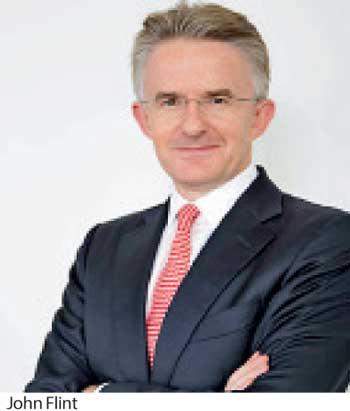Reply To:
Name - Reply Comment
 HONG KONG/LONDON (REUTERS): HSBC Holdings reported a jump in annual pre-tax profit that missed expectations and unveiled a plan to raise up to US$7 billion over the next four months to bolster its capital base, as the bank prepares for growth under a
HONG KONG/LONDON (REUTERS): HSBC Holdings reported a jump in annual pre-tax profit that missed expectations and unveiled a plan to raise up to US$7 billion over the next four months to bolster its capital base, as the bank prepares for growth under a
new leadership.
Europe’s biggest lender by market capitalisation has undergone a painful restructuring under Chief Executive Stuart Gulliver that has seen the bank cut thousands of jobs, shut branches and exit markets. The restructuring, coupled with a beneficial market environment, is now paying
off for HSBC.
Gulliver is stepping down after more than seven years at the helm and will be replaced by company veteran John Flint.
HSBC reported yesterday a profit before tax of US$17.2 billion for 2017, compared with US$7.1 billion the year before but below the US$19.7 billion average estimate of 17 analysts polled by Thomson Reuters.
Those estimates did not all take into account a US$1.3 billion writedown for 2017 that HSBC took, triggered by cuts in the U.S. corporate tax rate which meant banks had to book losses on deferred tax assets they built up during loss-making times. Its year-ago profit figure reflected a US$3.2 billion impairment of goodwill in the global private banking business in Europe and the impact of its sale of operations
in Brazil.
The lender said it was planning additional tier 1 capital issuance of between US$5 billion and US$7 billion during the first half of 2018, and that it would undertake share buybacks “as and when appropriate”.
HSBC shares fell as much as 3.2 percent in Hong Kong following the announcement, as investors registered the profit performance and disappointment over the absence of a share buyback. John Flint, who has been with the bank since 1989 and most recently as the head of its retail banking and wealth unit, will be charged with steering HSBC back to growth and will likely look East, with plans to further a strategy of investing in China’s southern Pearl River Delta region.
“We’re 2,500 people at the end of last year, we would continue to invest and add headcount, the opportunity for this organization is very compelling,” Flint told Reuters yesterday.
Those growth plans should be helped by a more favourable interest rate environment for the bank’s deposit-heavy franchise than his predecessor enjoyed.
Rising interest rates helped the bank to increase revenues in its retail division by 9 percent in 2017, particularly from growing deposits and charging higher spreads in its second home market of Hong Kong.
HSBC grew revenues in its investment banking division by a more modest 3 percent, a relatively strong performance given the subdued market environment throughout 2017 that hammered banks’ bond trading income in particular.
Flint said he will update investors with his thoughts on where to take the bank’s strategy before it reports half-year results in June.
That could include the results of a review into HSBC’s underperforming U.S. business which has long suffered from a lack of scale and the after-effects of the bank’s disastrous acquisition of Household International in 2003.
“We are doing a piece of work around the U.S. business at the moment, I don’t want to prejudge any conclusions,” Flint said.
HSBC’s common-equity tier 1 ratio, a key measure of financial strength, was 14.5 percent in 2017, compared to 13.6 percent last year and 11.9 percent in 2015.
Its reported revenues rose to US$51.4 billion from US$48 billion a year ago.